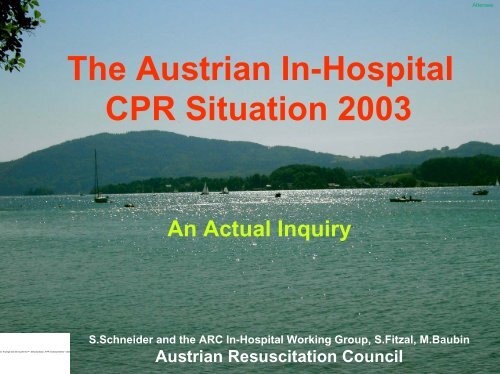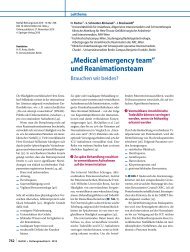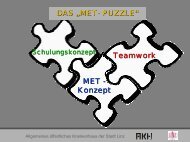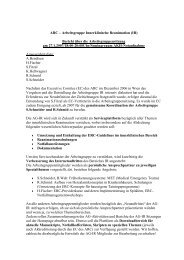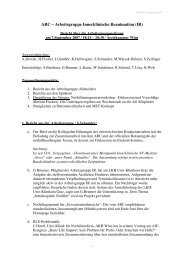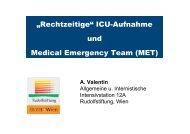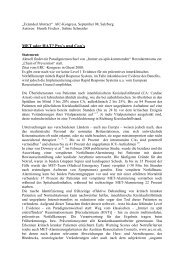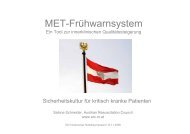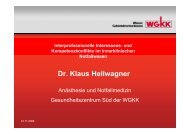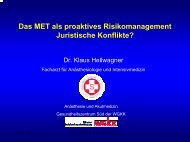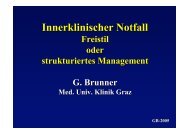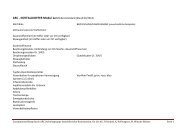CPR Situation in Österreich - Austrian Resuscitation Council
CPR Situation in Österreich - Austrian Resuscitation Council
CPR Situation in Österreich - Austrian Resuscitation Council
Create successful ePaper yourself
Turn your PDF publications into a flip-book with our unique Google optimized e-Paper software.
AtterseeAtterseeThe <strong>Austrian</strong> In-Hospital<strong>CPR</strong> <strong>Situation</strong> 2003An Actual Inquiryur Anzeige wird der QuickTime Dekompressor „TIFF (Unkomprimiert)“ benötS.Schneider and the ARC In-Hospital Work<strong>in</strong>g Group, S.Fitzal, M.Baub<strong>in</strong><strong>Austrian</strong> <strong>Resuscitation</strong> <strong>Council</strong>
Objective & Methods‣ To evaluate the current situation of organisationand outcome of <strong>CPR</strong> <strong>in</strong> <strong>Austrian</strong> hospitals‣ Prospective e-mail <strong>in</strong>quiry (06-12 2003) among <strong>in</strong>hospitalquality managers / medical directors <strong>in</strong> allaustrian hospitals with 24-hours supply (n=277)‣ Standardized questionnaire on: organization,logistic, equipment, acute response team, <strong>CPR</strong>tra<strong>in</strong><strong>in</strong>gand outcomePerformed by: ARC-In-Hospital Work<strong>in</strong>g Group / Medical Association of Vienna
Return Rate & EvaluationRate of return:overall: 41,1 % (n = 114 */277)Acute-Hospitals: 48,6 % (n = 87/179)Evaluation:Answers of 114 hospitals with a total number of38.865 beds* 277 Hospitals <strong>in</strong> Austria, from them 179 acute hospitals (Reference: BMGF 3.04)ERC Budapest, 9.9.04ARC/IR data unpublished
Availability of anEmergency Team?In 60% (n=67) a specialteam is responsible,<strong>in</strong> 40% (n=47) thepersonal on dutymanages CA and/oremergenciesspecial teampersonal ondutyn=114 Reihe1 67 47ERC, 9.04ARC/IR
Emergency TeamResponsibilityResponse <strong>in</strong>terval < 4 m<strong>in</strong>2%10% No6%n=6792%92%90% Yesall emergencies only cardiac arrest no answerERC, 9.04ARC/IR
Emergency CallSpecial emergency number?Yes: 84 % (n = 96)No: 16 % (n = 18)Amount of emergency calls per year?• 5 % (n = 6) exact data• 55 % (n = 63) estimate the number of calls• 40 % (n = 45) unknownERC, 9.04ARC/IR
Standardized Alert Criteria?52,6 % answered YES, (although some of these affirm<strong>in</strong>ghospitals did not have an organized emergency team)58,3 % of these use pathophysiological criteria40 % use an operator and have no direct call<strong>in</strong>gERC, 9.04ARC/IR
Emergency EquipmentStandardizedemergency case?86% (n=98)Defibrillatoravailable on everyward/floor46% (n=52)AED‘s <strong>in</strong> thehospital?45% (n=51)ERC, 9.04ARC/IR
<strong>CPR</strong>-Tra<strong>in</strong><strong>in</strong>g-Programme• 96 % (n=109) offer <strong>CPR</strong>-tra<strong>in</strong><strong>in</strong>g• 86 % (n= 94) offer a repeat<strong>in</strong>g <strong>CPR</strong>-tra<strong>in</strong><strong>in</strong>g, ma<strong>in</strong>ly every year• 76 % (n= 83) tra<strong>in</strong><strong>in</strong>g is obligatory• 20 % (n= 22) have a budget for tra<strong>in</strong><strong>in</strong>gWho is tra<strong>in</strong>ed?• 27 % (n=29) whole staff• 46 % (n=50) nurs<strong>in</strong>g staff only• 34 % (n=37) doctors <strong>in</strong> tra<strong>in</strong><strong>in</strong>g only• 14 % (n=15) licenced physicians onlyERC, 9.04ARC/IR
Documentation & Outcome• 39 % (n = 44) document <strong>CPR</strong> attempts, 30/44 on anot-standardized form, 14/44 electronically• 12,3 % (n = 14) analyse the dataIs discharge after CA measured?• Detailed <strong>in</strong>formation <strong>in</strong> 3,5 % (n = 4/114) hospitals• Estimation <strong>in</strong> 14 % (n = 16) hospitals with a 0-100%survival rate• No data/no answer <strong>in</strong> 94 hospitalsERC, 9.04ARC/IR
Summary• 59 % of the <strong>Austrian</strong> hospitals have a special organizedemergency team. Most of these respond not only to a cardiacarrest alarm, but to other emergencies also. There are no specialalert criteria of physiological changes <strong>in</strong> patients at risk.• 54 % of the <strong>Austrian</strong> hospitals are equipped with less than onedefibrillator per ward/floor, 45% are partially equipped withAED‘s.• Regular (obligatory) and repeated <strong>CPR</strong>-tra<strong>in</strong><strong>in</strong>g of the whole staffis not the rule; a budget for tra<strong>in</strong><strong>in</strong>g is available <strong>in</strong> 20% only.• Documentation is done <strong>in</strong> 39% only, on a not-standardized formand only 12 % (n = 14) of the hospitals analyze their data.Outcome is unknown <strong>in</strong> most of the hospitalsERC, 9.04ARC/IR
ConclusionWe need an emergency system <strong>in</strong> every hospital,which manages the follow<strong>in</strong>g key areas:‣ Provid<strong>in</strong>g a rapid and effective resuscitation response• Regular tra<strong>in</strong><strong>in</strong>g of the whole hospital staff (medical and non medical) <strong>in</strong>BLS+AED-techniques and selected staff <strong>in</strong> advanced life support skills• Standardized equipment + AED with<strong>in</strong> 3 m<strong>in</strong>‣ Identify<strong>in</strong>g patients at risk and apply<strong>in</strong>g preventative strategies• Standardized set of call<strong>in</strong>g criteria identify<strong>in</strong>g life threaten<strong>in</strong>g‣ Identify<strong>in</strong>g futility• DNR-order on the ward‣ Audit<strong>in</strong>g resuscitation to achieve quality improvement• Documentation of emergency calls accord<strong>in</strong>g to Utste<strong>in</strong>-Style• Data analysis
Thank you
ARC In-Hospital Work<strong>in</strong>g Group• Doz.Dr.Michael Baub<strong>in</strong> (T)• Prof.Dr.Gernot Brunner (Stk)• Prof.Dr.Hans Domanovits (W)• Dr.Henrik Fischer (OÖ)• OA Dr.Christian Helbok (V)• OA Dr.Dieter Kopper (K)• DGKS Lydia Kautz (B)• OA Dr.Raimund Kraschl (K)• OA Dr.Sigrid Ofner (S)• Prof.Dr.Fritz Rauscha (W)• DGKP Wilfried Schabauer (T)• OA Dr.Ra<strong>in</strong>er Schmid (W)• Prim.Dr.Helmut Trimmel (NÖ)• Dr.Thomas Uray (W)• DGKS Birgit Weh (OÖ)Conduction: Dr.Sab<strong>in</strong>e Schneider (W)www.arc.or.atARC/IR


